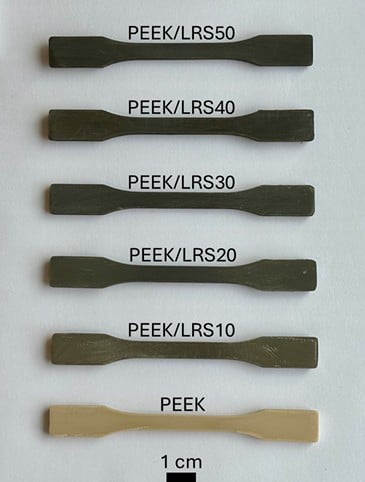3D printing is going to be a critical technology in space exploration, both for its ability to create almost any object, but also because it can utilize in-situ resources, at least in part. However, the more of those space resources are used in a print, the more the mechanical properties change from that on Earth, leading to problems with tensile or compressive strength. But a new paper from researchers at Concordia University hit a new milestone of how much lunar regolith can be used in a mixed feedstock for additive manufacturing, making it possible to use even more locally sourced material, and saving more launch cost, than ever before.
The research mixed lunar regolith simultant, which is material created to mimic how the material on the surface on the Moon works, with polyether-ether-ketone, more commonly known as PEEK. PEEK is a thermoplastic already in wide use in 3D printing, but previous efforts to combine it with lunar regolith have faltered. They suffered from extrusion challenges, as the regolith, which is made up of hard individual particles, made it difficult to extrude without simply blowing dust all over. Additional problems resulted from the porosity of the material that was printed, which led to decreased tensile strength and increased brittleness.
Modifications to the 3D printing method seemed to be the answer to those problems. There were two main advancements in technology discussed in the paper – a screw configuration and a different type of “raft” used to bond the printed material to the print bed.
Fraser discusses how resources on the Moon are going to be so important to our expansion of the solar system.
Combining lunar regolith simulant (LRS) with PEEK is a tricky business, so the researchers, led by Mohammed Azami of Concordia’s electrical engineering department, decided to use a novel “twin screw” configuration. Torque was a factor in previous iterations of the mixing machine, as higher regolith content meant higher torque, eventually limiting the total percentage of regolith mixed with the PEEK to around 30%. With the new configuration, the researchers were able to get concentrations of up to 50% of the regolith when combined with the PEEK.
However, when those parts were printed, they started to delaminate and warp. While common in prints of just PEEK itself, the addition of the regolith exacerbated the problem. To solve it, the researchers used a “raft” – a type of intermediate layer to help the print bond to the main printing plate. In their case, they used a different type of thermopolymer, known as polyether-ketone-ketone (PEKK) as the raft, and implemented a dual-nozzle system, where the PEKK was printed using one nozzle and the combination LRS/PEEK was printed using the other.
After they got the higher concentrations of LRS and overcame the delamination/warping problem, the researchers decided to anneal their samples. The annealing process seemed to improve some of the mechanical properties of the print, but only up to a point. At higher concentrations of LRS, the benefits of annealing were not as apparent due to breaks in PEEK’s polymer chain, which benefits from annealing, because of the increased number of regolith particles.
Fraser discusses why 3D printing is so critical to space exploration.
As with all good papers on 3D printing new material, the authors then looked at the mechanical properties of their output. While there was a noticeable increase in stiffness, there was a steady decrease in tensile strength, which was exacerbated at higher LRS concentrations. The combined material also had decreased “elongation at break” (i.e. increased brittleness), but ultimately the researchers determined that the best trade-off for using in-situ material was around a mix of 60% PEEK and 40% regolith. This mixture doesn’t suffer from some of the more severe degradation of mechanical properties while still utilizing as much local resources as possible.
There is undoubtedly still room for improvement here, as this is very early on in experimentation with these materials. In the future, the researchers plan to try combining the LRS with different polymers, and do more of their testing / manufacturing in simulated lunar environments, such as a vacuum and decreased gravity. It will be a while before 3D printing makes up a large percentage of the material used on the Moon, but that time is surely on its way, and these first early steps at experimentation are how we will eventually get there.
Learn More:
M. Azami et al – Additive Manufacturing of PEEK/Lunar Regolith Composites for Sustainable Lunar Manufacturing
UT – Quality Of 3D Printing With Lunar Regolith Varies Based On Feedstock
UT – 3-D Printing on the Moon. From Regolith to Paste to Useful Objects and Structures
UT – NASA Sends a 3D Printer for Lunar Regolith and More to the ISS
